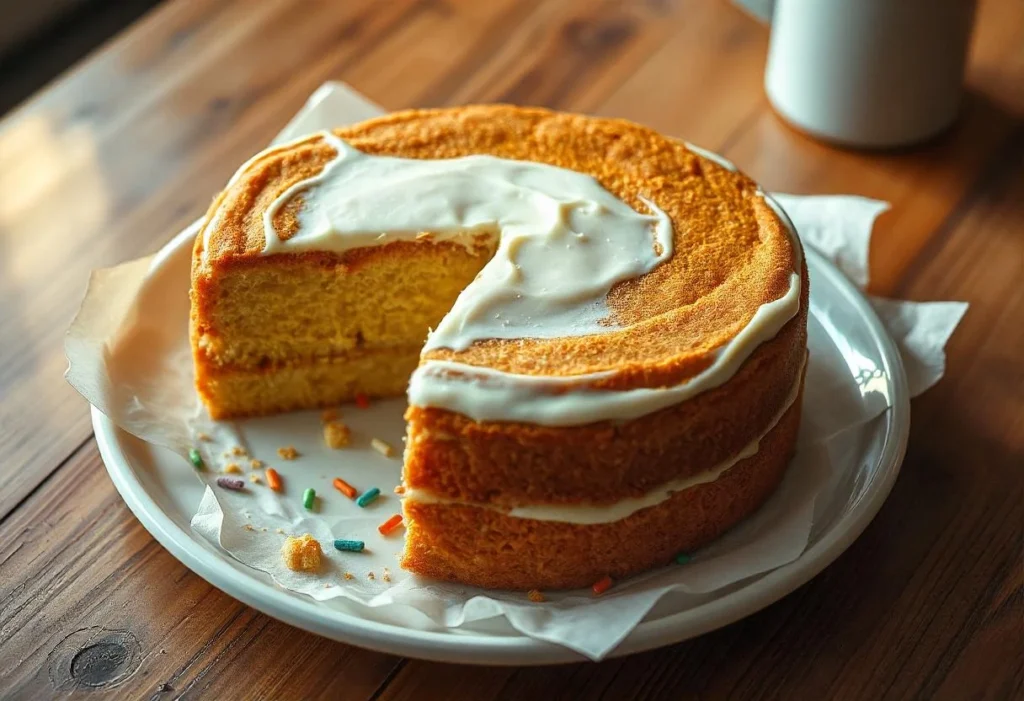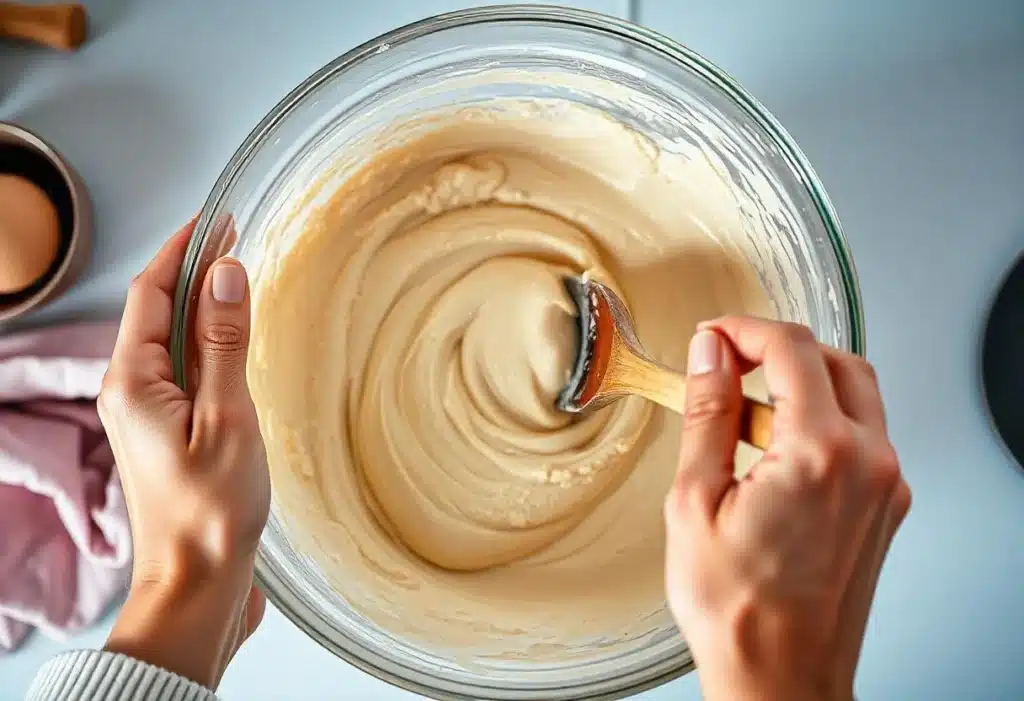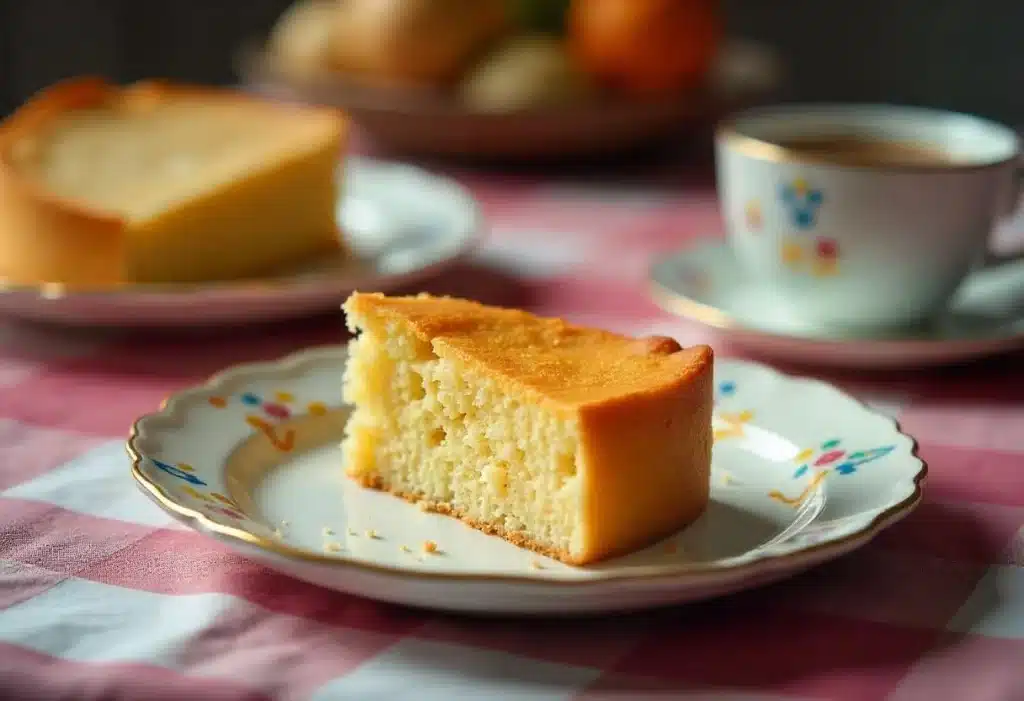Hey there, food lovers! Okay, let’s dive right into something super comforting and nostalgic. Have you ever found yourself thinking back to childhood treats and wondering, What is school cake called? Because if that simple, sprinkles-topped cake holds a special place in your heart, you’ve definitely landed in the right spot! Especially for anyone who grew up in the UK, this humble traybake is like a time machine on a plate, instantly zapping you back to school lunchtimes and carefree days. My husband keeps asking if it’s just “that sprinkle cake,” but oh, it’s so much more – it’s a taste of childhood!
Now, you might have heard whispers of Tottenham cake or seen similar little treats, but the classic school cake? It’s got its own unique charm. So, come hang out in my virtual kitchen while we figure out what makes this cake so special and why just thinking about it makes so many of us smile.
Historical Context – Origins of School Cake
Okay, story time! The tale of school cake is pretty sweet and takes us right back to old-school British school canteens. Nonna always said the best food often comes from simple needs, and that’s totally true here. Back in the day, school lunches needed to be filling, tasty (enough for kids!), and most importantly, affordable for feeding crowds of hungry little ones. School cake fit the bill perfectly! The recipes were designed to be straightforward, using basic pantry staples that schools could get easily and cheaply. It was a practical, delicious solution!
Because the ingredients were so simple, it also meant families could easily bake it at home, making it even more popular. That connection to shared memories, to simpler times – that’s a huge part of its magic, don’t you think? It’s comfort food history!
Why is it Called a School Cake?
Well, this one’s pretty straightforward, right? It’s called “school cake” because… surprise! It was a classic dessert served in UK schools for ages (and still is in many!). The name instantly connects it to those school dinner memories – the lunch queue, the chatter, maybe swapping pudding with a friend. It’s not just a label; it’s a direct line to that feeling of nostalgia and the cake’s place in everyday British culture.
Variations and Types
So, while we adore the classic, plain-Jane school cake, like any good recipe, it’s got some fun cousins and variations floating around. Let’s check ’em out:
Is School Cake the Same as Tottenham Cake?
This comes up a lot! Are they twins? Nope, more like close cousins. Tottenham cake, hailing from Tottenham in North London (makes sense!), shares that simple, delicious sponge base baked in a tray. The big giveaway difference? The look! Tottenham cake rocks a signature bright pink icing (originally made with mulberries, how cool is that?!) and is often showered with desiccated coconut instead of just sprinkles. Same family, different party dress!
Different Names for School Cake Across Regions
While “school cake” is the most common name, depending on where you grew up in the UK, you might have called it something else! “Dinner cake” or just plain “traybake” are other contenders, highlighting its role as a school dinner pud and its baking style. These little regional differences just show how much this simple cake is loved and woven into local traditions. Whatever you call it, everyone knows that yummy, sprinkle-topped square!
What is the Small Cake Called?
Thinking smaller? If you’re picturing mini versions of school cake, you might be thinking of fairy cakes (classic British!), cupcakes, or even just little squares cut from the main traybake. You can totally adapt the school cake recipe to bake in cupcake liners – perfect for parties or individual treats. Plus, decorating mini ones is always fun!
Ingredients and Recipe
Okay, enough chatting, let’s get baking! Time to roll up those sleeves and fill the kitchen with that amazing cake smell. Understanding the basics is key – knowing what are the 5 main ingredients in cake helps demystify any recipe! This classic school cake recipe is wonderfully simple and perfect for bakers of all levels. Looking for an easy-to-follow recipe with extra tips? Check out our dedicated school cake recipe page!
Classic School Cake Recipe
Here’s a step-by-step guide to baking up those happy memories:
Items:
- 225g (about 1 ¾ cups + 2 tbsp) plain flour (All-Purpose flour)
- 225g (about 1 cup + 2 tbsp) caster sugar (Superfine sugar – regular granulated works too!)
- 225g (1 cup or 2 sticks) butter or margarine, nice and soft
- 4 large eggs, preferably room temperature
- 4 tablespoons milk, room temperature is good
- 2 teaspoons baking powder (make sure it’s fresh!)
- For the Icing: About 200g (1 ½ – 2 cups) icing sugar (powdered sugar), sifted
- A few tablespoons of water
- Rainbow sprinkles! (Non-negotiable, right? 😉)
Instructions:
- Get Ready: First things first, preheat that oven to 350°F (180°C / 160°C fan / Gas Mark 4). Grease and line a rectangular baking tin (roughly 9×13 inches is perfect) with parchment paper. Don’t skip this – sticking is sad!
- Dry Stuff Together: In a medium bowl, whisk together the flour and baking powder. This helps make sure the baking powder gets evenly distributed – no weird lopsided bits!
- Cream Wet Stuff: In a separate large bowl, cream the softened butter (or margarine) and caster sugar together with an electric mixer (or a wooden spoon and some elbow grease!) until it looks pale and fluffy. This takes a few minutes but adds air, making the cake lighter.
- Add Eggs: Crack in the eggs one at a time, beating well after each addition until it’s all smooth and combined. If it looks like it might curdle, add a tablespoon of your flour mixture with the last egg.
- Combine Gently: Now, add about half the flour mixture to the wet ingredients, mix gently on low speed (or fold with a spatula). Add the milk, mix gently. Add the remaining flour mixture and mix just until everything is combined. Seriously, don’t overmix! Overmixing = tough cake. We want tender!
- Bake Time: Pour the lovely batter into your prepared tin and gently spread it out evenly with your spatula. Pop it into the preheated oven and bake for 20-25 minutes. You’ll know it’s done when it’s beautifully golden brown, springy to a gentle touch, and a skewer inserted into the center comes out clean.
- Cool Down: Let the cake cool in the tin for about 10 minutes – this helps it settle. Then, carefully turn it out onto a wire rack to cool completely. Patience, my friends! Icing a warm cake leads to a melty mess.
- Icing Fun: Once the cake is totally cool, make the icing. Sift the icing sugar into a bowl (sifting prevents lumps!). Add water, just a tiny bit at a time (start with 1-2 tablespoons), mixing until you get a smooth, thick but spreadable paste. Not too runny!
- Ice, Ice Baby & Sprinkle!: Spread the icing evenly over the top of the cooled cake. Immediately shower it generously with those colourful rainbow sprinkles! Let the icing set for a bit before slicing into squares.
Nutritional Content
| Nutrient | Amount (approx.) |
|---|---|
| Calories | 380-420 kcal |
| Fat | 20-22 g |
| Carbohydrates | 45-50 g |
| Protein | 5-7 g |
Note: These numbers are just ballpark figures! They can change based on the exact ingredients you use and how big you cut your slices (no judgment if they’re generous!).
Tips for Perfect
- Seriously, don’t overmix once the flour goes in! Mix until just combined. A few lumps are okay. Overmixing = tough cake.
- Cool completely before icing! I know I said it before, but it’s crucial. Warm cake + icing = sticky, runny disaster.
- If your oven bakes unevenly (like mine sometimes does!), rotate the pan halfway through baking for a nice, level cake.
- Store leftover cake (if there is any!) in an airtight container at room temperature. It should stay lovely and fresh for a couple of days.
Want more general cake baking wisdom? This guide on common cake mistakes from Allrecipes is super helpful!
Modern Variations of School Cake
The beauty of a classic like school cake is that it’s easy to adapt! Need a gluten-free version? Swap the plain flour for a good quality gluten-free blend (make sure it has xanthan gum). Going vegan? Use plant-based butter/margarine, plant milk (like oat or soy), and an egg replacer like flax eggs. You can also play with flavours! Add a teaspoon of vanilla extract to the batter, a little lemon zest for brightness, or even some warming spices like cinnamon or nutmeg.
And that butter vs. margarine debate? Use whichever you prefer! Butter gives richer flavour, margarine can sometimes make it a tad lighter. Curious about what the pros use? Check out our article on does Mary Berry use butter or margarine? It’s all about finding what works for you!
Cultural Impact
School cake isn’t just flour and sugar; it’s baked-in nostalgia! It holds such a special place because it connects so many people to shared childhood memories.
- Why is School Cake Still Popular Today? It’s all about the feels! That simple, sweet taste instantly transports people back to simpler times, school days, maybe even birthday parties. Plus, with the rise of home baking, it’s a wonderfully easy and satisfying recipe to make – perfect for sharing and creating new memories!
- The Role of School Cake in Pop Culture: You see it pop up! Mentioned in British TV shows or books as a symbol of childhood, and it definitely has moments on social media where everyone starts baking and sharing their own versions. It’s instantly recognizable and taps into that collective warm-fuzzy feeling.
- School Cake Beyond the UK: While it’s a British icon, the idea of a simple, comforting sheet cake isn’t unique! Think of American Texas Sheet Cake or simple vanilla snack cakes. Many cultures have their own version of an easy, crowd-pleasing cake often baked in a tray. It just shows the universal love for simple, delicious treats!
Want to explore more classic bakes? BBC Good Food has a wonderful collection of classic cake recipes!
Frequently Asked Questions (FAQ)
Why is it called a school cake?
The name “school cake” is pretty self-explanatory! It earned this name because it was, and in many places still is, a staple dessert served in schools across the UK. It was a simple, budget-friendly and satisfying treat often served as part of the school lunch menu. This easy school cake recipe made it a perfect fit. It quickly became a comforting memory for countless generations of pupils and the simplicity of the recipe allowed schools to make large quantities.
Why is it called a Tottenham cake?
Tottenham cake, which is closely related to the traditional school cake, is said to have originated in Tottenham, North London, in the early 1900s. A local baker created this pink version of the sponge, and it soon became a local favorite, with many schools adopting the recipe. It’s typically pink due to added food coloring and features a generous sprinkling of sprinkles or desiccated coconut.
Is Tottenham cake the same as school cake?
While these two cakes are closely related, they are not exactly the same. School cake is typically plain, with a simple layer of white icing. Tottenham cake, on the other hand, is usually a vibrant shade of pink, and topped with sprinkles and coconut. They share a similar sponge recipe, but the additions give Tottenham cake a unique identity. It’s a regional variation.
What is the small cake called?
“Small cake” is a general term for various individual cakes like cupcakes, fairy cakes, or even muffins. If we’re talking about smaller versions of our school cake, these are simply miniature versions of the sponge, and can be baked in cupcake or muffin tins. These smaller portions of the classic cake are versatile and can easily be adapted with different shapes, sizes, and flavors.
So, there you have it, amici! The sweet story behind the beloved school cake. We’ve figured out what school cake is called (and its other fun names!), explored its simple origins, compared it to its pink cousin, and even got a recipe to try! It’s clear this isn’t just any cake; it’s a square slice of comfort, nostalgia, and happy memories wrapped up with simple icing and colourful sprinkles.
I really hope this little dive into school cake history and baking has inspired you! It’s such a wonderfully straightforward recipe – perfect for baking with kids (my little chatterbox daughter loves adding the sprinkles!) or just whipping up when you need a comforting treat. Why not give it a go? Experiment with toppings, maybe try that pink icing, and create your own happy memories.
School cake is a beautiful reminder that sometimes the simplest things are the best. It proves that you don’t need fancy ingredients or complicated techniques to make something truly delicious and heartwarming. Now, I’d love to hear from you! Does school cake bring back memories for you? Got any favourite variations or baking tips? Share them in the comments below! Buon appetito!




